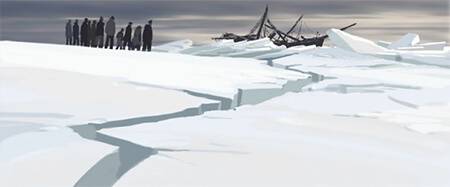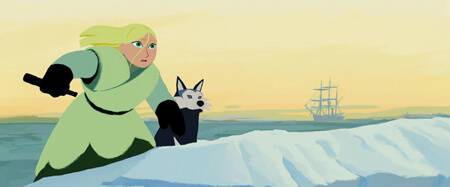Rémi Chayé’s “Long Way North” – Review
Set in 1892 Saint-Petersburg, Long Way North is a film that follows the story of Sasha, a young Russian aristocrat. Sasha’s grandfather, Oloukine, was a renowned explorer who never returned from his last expedition to the North Pole. Unbeknownst to Sasha’s family the new scientific adviser to the Tsar, the Tsar’s nephew, is looking for an excuse to discredit Oloukine and so using Sasha’s wish to resume the search for her grandfather as a tool, he strips Sasha’s father of his promotion and declares that a new library at the Academy of Science that was to be named after Oloukine will be named after someone else. To save her family’s honour and Sasha runs away from home and follows her Grandfather’s trail in search of his famous ship.

Long Way North (Dir. Rémi Chayé)
In terms of story and theme, the film is similar to Disney’s Mulan; the idea of saving the family honour is powerful and the struggles that Sasha has to overcome are great. Reaching the coast was comparatively easy compared to proving her determination to charter a ship to go north and overcoming sexism to gain passage, not to mention the epic battle that Sasha and the crew must fight against nature as Winter comes in and they become stranded on the arctic ice. Sasha comes across as a character who you can really feel for; she does not have an iron will; she is a fifteen-year-old who has run away from home and is out of her depth, but she keeps going anyway out of love for her family. Her character has real depth and makes the story incredibly immersive.
Lund and Larson – the Captain and First Mate of the ship Sasha gains passage on – are brothers who don’t always see eye-to-eye, but still care for each other deep down. They were left their ship by their father, but while Lund is responsible, Larson gambles and can’t take things seriously. Their story arc acts almost as a clone of that of Sasha with her father and happens so that Larson must prove his mettle at the same time as Sasha. They become unlikely allies in the frozen tundra and their relationship keeps the audience invested as the rest of the crew begin to turn nasty as food begins to run out.
Watching the teaser trailer for the film gives an idea of what its beautiful graphic style looks like in motion. The final film is quite different from the teaser however; the basis for the final animation style is there but it doesn’t have the same texture, depth or saturation of colour as the final film. Sasha is a person with a loving, hopeful heart and the warmth of the colours of the film reflect that. It is only in a couple of moments of the film when Sasha is closest to despair; when her family is discredited and when she and the crew are starving on the ice; that the film takes on the tone of Sasha’s feelings and becomes desaturated.
The graphic style of the film is beautiful to watch and suits the setting very well. The limited colour palette and tri-tone shading is perfect for the snow and ice of the arctic, and also works very well in the heart of Saint Petersburg. In her family home Sasha is not happy; her parents are trying to make her the ‘prefect lady’ and marry her off; so the only peace she can find is in her Grandfather’s old study. The limited graphic palette in this setting that in real life is hyper-detailed helps to echo the monotone life that Sasha leads there. In contrast the limited colour palette in the Arctic echoes the freedom and happiness that Sasha feels.
The animation of the film is lovely – using vector shapes the animation is easy to read, fluid and surprisingly versatile. There is a particular shot in the film where Sasha is hanging from the rigging and her hair is blowing in the wind, and the amount of motion that the animators could get from three colours with no lines was amazing! Similarly before Sasha begins to face any real challenges, the animation was beautiful but the movements were limited – in Russian aristocratic society at the end of the 19th century ladies were not supposed to move wildly. When she begins to be challenged however, learning to work for what she wants the animation reflects her breaking from society; she crazily chops vegetables, manically serves tables and frantically cooks in her efforts to help Olga, the pub landlady who helps her gain passage on a ship.

Long Way North (Dir. Rémi Chayé)
To summarise, Long Way North is a powerful film about a girl’s struggle to save her family’s honour, though in the end she does more than that. It is a well-crafted, visually stunning story that is well worth a watch.
Rémi Chayé’s Long Way North won the Audience Award for Feature Film at Annecy 2015. For updates on the film visit urbandistrib.com/films/long-way-north/



